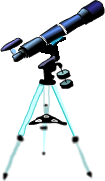Thomas Harriot at Syon Park
Created | Updated Aug 8, 2010

Telescope 400
2009 is the International Year of Astronomy and celebrates 400 years of science since Italian astronomer Galileo di Vincenzo Bonaiuti de Galilei first turned a telescope towards the night sky. From his subsequent discoveries, published in his book Sidereus Nuncuis (the Starry Messenger), using one of the first primitive telescopes, he is now recognised for these and other discoveries that heralded the opening of a new scientific age.
He was however, not the first to use a telescope on the night sky. That honour belongs to a lesser known Englishman, Thomas Harriot, whose observations of the Moon pre-dated those of Galileo by some four months; the difference being that although Harriot recorded his observations, he did not publish them as Galileo did, and unfortunately there are no prizes for coming first if no one knows about it.
Harriot was a scholar, educated at Oxford, and a contemporary of other Elizabethans such as Shakespeare, Marlowe, Sir Francis Drake and Sir Walter Raleigh. In his early career he was employed by Raleigh at Durham House in the Strand, London, to instruct Raleigh's sea captains in navigation skills. Later in 1585 he accompanied Raleigh to Virginia in the new world to map coastlines and survey for natural resources.
In 1591, Harriot moved to the estate of Henry Percy, Ninth Earl of Northumberland, at Syon Park, Twickenham, near London, where he lived for a number of years, during which he made the greater part of his astronomical discoveries. With the Earl as his patron, Harriot was able to continue his observations and experiments and entered a period of discovery in science and astronomy.
A greater recognition is gradually coming Harriot's way after the discovery of his records, but it is unlikely that he will ever usurp Galileo's pre-eminent position. Nevertheless, on 26 July 2009 he was honoured with an exhibition, Telescope 400, at Syon House, commemorating his life and work there. The exhibition took place on the anniversary of his earliest recorded observation of the Moon using a telescope. From that observation he produced the first drawing of its features, which is clearly annotated with the date 26 July, 1609.
Telescope 400 was set in the house and grounds of Syon Park. The adult entry fee of £9.00 also included access to the house and the extensive beautifully manicured gardens. The various features of the exhibition were sited around the lawn at the front of the house, the Great Conservatory, and the basement room of the house itself for lectures.
The front lawn was home to trade stands and demonstrations. Telescopes and scientific equipment and toys were on offer by a couple of vendors, including a raffle for a small telescope. Demonstrations of creating a mini comet from dry ice by Dr Robert Massey through the afternoon were popular, while children were encouraged to make and launch water propelled rockets, introducing them to the principle of action and reaction. Others fashioned star finding wheels or sundials while the 'ghost' of Thomas Harriot walked among us during the afternoon.
The Great Conservatory housed the main part of the exhibition. There were stands run by the South Downs Planetarium, who had prepared a fascinating little booklet on Harriot's life and works, and hands-on science experiments by Herstmonceux Observatory Science Centre included facsimiles of Harriot's drawings and notes. A mini, child sized, inflatable planetarium also housed short demonstrations of stars and planetary motion.
A couple of notable demonstrations with telescopes from either end of the 400 years made an interesting comparison. A modern solar telescope looking at the current inactivity on the Sun's surface, and a facsimile of Harriot's telescope, aimed at a photograph of the Moon on the other side of the garden, compared old with new.
This year also happens to be the 40th anniversary of the first moon landing in 1969. Back in the house basement, three lecturers gave talks of 20 minute duration on various aspects of space travel. A talk on Apollo 11 given by broadcaster Ian Ridpath was complemented by others on a 'Return to the Moon', and 'Living in Space' by BBC special effects man Matt Irvine, and Greenwich Observatory astronomer Greg Smye-Ramsby respectively.
Other activities included the choral group Cantamus, who gave their renditions of music and madrigals from Harriot's day, and at 4.30pm a plaque was unveiled by Lord Egremont, commemorating Harriot's life and work at Syon. That evening, 250 ticket holding guests were treated to a reception and an evening lecture on Harriot, by Dr Allan Chapman in a marquee in the grounds, which wrapped up the day's events.
All in all, a fitting tribute to a largely unknown Englishman whose achievements rivalled any of the better known scientific 'names' from history.
